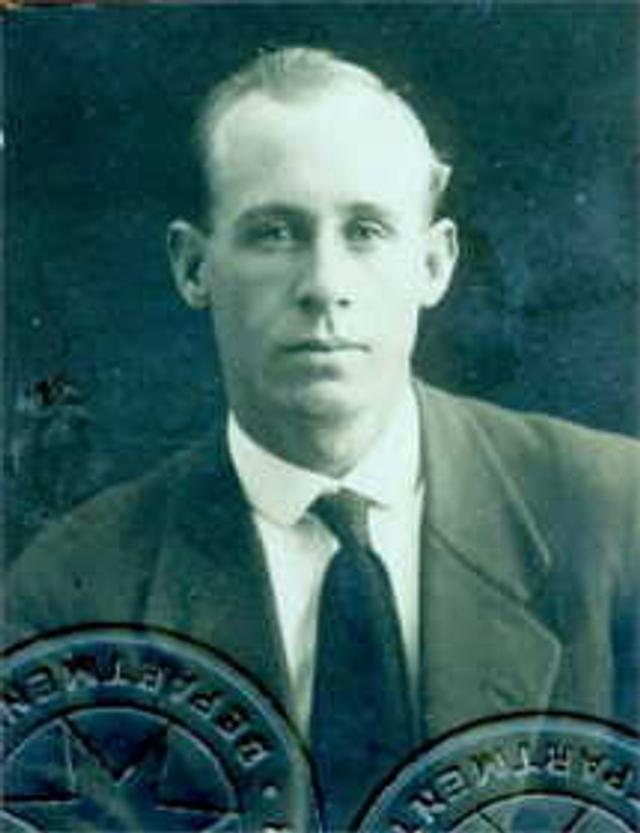Jack Roy Douglass
Jack Roy Douglass
Drowned in estuary; body recovered
27 May 1926

Jack Roy Douglass as Ernest Brogmus

Rhona Douglas
Jack Roy Douglass was born in Sydney, New South Wales December 1899. Jack spent the first part of his life as Ernest Alfred Brogmus. His father was Hans August Brogmus and his mother was Ada Elizabeth Knight.
Ernest enlisted in the army on 26 March 1917. He was 17 years of age, so he claimed he was born on 9 December 1898 so he could join up. He left his farm hand job and boarded the Borda destined for England. He was shipped to France in January 1918.He was shot in his right thigh on 24 April 1918 at Villiers-Bretonneux. Ernest was shipped back to Fremantle aboard the Ulysses, and he required surgery during the voyage. He was discharged from the army on 26 March 1919. He was awarded the 1914-1915 Star, the British War Medal 1914-1920 and the Victory Medal.
Jack’s changed date of birth remained in his identification. In 1923 Jack married Leila Marion Criddle from Dongara. Sadly, Leila died on 15 March 1924 at Fremantle. He had a daughter born in 1925, Gloria Leila Southwood. He fathered another daughter Rhona Jacqueline Douglas born on 21 December 1925. On 4 February Jack married her mother, Thelma May Southwood in the Church of England in Bunbury. For some time until 1926 Jack was part of the crew on the steamship Apolda.
In Bunbury Jack and his brother-in-law Ernest Tomlinson worked as lumpers [stevedores and wharf labourers who load and unload vessels]. Bunbury lumpers supplemented their inconsistent income by net fishing in the Leschenault Estuary.
On 27 May the men went to set their fish nets in the estuary at the third sand patch, their usual place. Jack arrived at the netting place first, but didn’t wait for Ernest who was late. The weather became squally around midnight. It was cold. Jack wore two singlets, a shirt, three sweaters, an oilstone jacket, and oilskin pants.
Jack was last seen by another lumper/fisher called George Clark near Black Point (the third sand bar) between 10 and 10.30pm on 27 May. While waiting for his fishing partner, Tom, he remembered commenting that Jack was starting late that night. George told PC White and Ernest that there had been a heavy storm that night.
When Jack didn’t return the following day, his family contacted the police and Police Constable White accompanied Ernest while he went to their usual netting spot at the estuary. They did not find Jack or any of his equipment.
On 29 May 1926 Ernest received a telephone call from PC White advising him his boat had been discovered floating on the river. It contained an old overcoat, a crib can [metal lunch box] and a small number of fish. There was an oar missing from the boat. On 30 May Ernest went to see the boat and identified it as his own. He and PC White found the fishing net set approximately three quarters of a mile [1.2 kms] offshore.
Jack’s body was recovered on 3 June. When discovered by a member of the public he was still wearing his heavy clothing. Police Constables White and Marriott and the undertaker took a coffin to the Parade Hotel where they were picked up in a launch. They towed the coffin in a dinghy to the estuary to collect Jack’s body. By the time they arrived at the site described by the finder, darkness was falling.
The man who made the grisly discovery did not realise that without tethering the body, It would float with the tide as it came and went. By the time he reported his discovery and the police, and the undertaker arrived, the body had moved.
A search party was organised. The launch was tied up, and the men used small row boats to navigate the rivers and small inlets in the estuary. They found the body approximately one and half miles in a blind channel. The search party put Jack in the coffin and then towed it back to Bunbury for a postmortem.
Dr Cullen conducted the autopsy on 7 June. He reported that Jack’s skin was turning green from being submersed in the estuary water. There were no signs of external injury, no fractures, head injuries or open wounds. Three of Jack’s teeth were missing, and crabs had eaten part of an ear. Dr Cullen commented it would have been difficult for Jack to swim in the heavy clothing he wore. He concluded Jack had mistaken his direction and drowned from exhaustion, or drowned attempting to regain the boat in the storm. He may have been struck on his head and rendered unconscious.
Jack’s funeral was on 7 June 1926. It was well-attended by many friends and family members. There were many wreaths adorning the coffin and the church, including one from the Bunbury Waterside Workers. Jack was buried in the Church of Christ section of the Bunbury Cemetery.
Dr Cullen reported to the Coroner’s Court on 8 June where Jack’s death was determined to be death by drowning, although there was no evidence to show how Jack came to be in the water.
